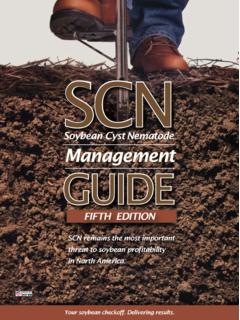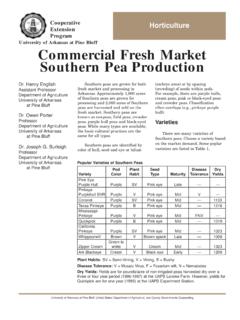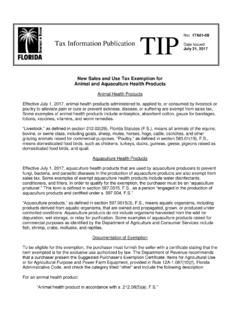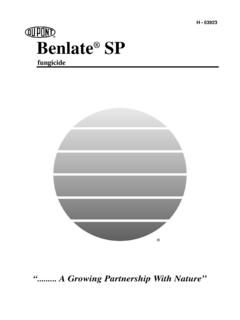Transcription of White Mold - NCSRP
1 1 SOYBEAN disease MANAGEMENTW hite MoldWhite mold (also called Sclerotinia stem rot) is a significant problem in the North Central soybean production region and Canada. Caused by the fungus Sclerotinia sclerotiorum, this disease varies in incidence and severity from year to year because of its sensitivity to weather. White mold can substantially reduce yield, especially when climate and management practices favor high yield a management plan based on knowledge of field history and best disease management practices can help reduce losses from White mold . Integrating several management tactics that include cultural practices, varietal resistance, and chemical and biological control can be part of an effective White mold management plan.
2 CPN-1005 Figure 1. (A) Sclerotia of S. sclerotiorum in harvested grain, and (B) infected seed with a sclerotium in a Loss and Seed InfectionWhite mold causes yield loss to soybean by reducing seed number and weight. Potential yield loss can be based on estimates of disease incidence in several sections of the field. disease incidence is defined as the number of plants that express symptoms of White mold divided by the total number of plants assessed. For example, if 100 plants were examined and 45 had symp-toms, the incidence would be 45 percent. For every 10 percent increase in the incidence of White mold observed at the R7 soybean growth stage (beginning maturity), yield is reduced by two to five bushels per acre.
3 AB2 Soybean disease ManagementWhite MoldIn addition to causing yield loss, White mold can affect seed quality and seed production. Sclerotia may be observed in harvested grain (Figure 1), which may cause price discounts for foreign material delivered at the elevator. S. sclerotiorum can infect soybean seed (Figure 1) and be an important source of inoculum if planted into fields with no history of White mold . Infected seeds can have reduced germination, and in some cases, oil and protein concentrations also can be and disease CycleSclerotinia sclerotiorum survives in the soil as sclerotia, which are hard, black structures that resemble mouse droppings. When soils are shaded, moist, and cool (40-60 F/5-16 C), sclerotia within the top 2 inches of the soil profile can germinate to produce apothecia.
4 Apothecia are small (approximately 1 8- to 1 4-inch in diameter), tan, cup-shaped mushrooms. Apothecia Figure 2. The three components required for White mold to occur are: (A) susceptible soybean varieties that are flowering, (B) apothecia, which produce S. sclerotiorum spores, and (C) a cool, wet environment, especially under the soybean canopy. When all occur at the same time, White mold (D) can millions of spores called ascospores that typically infect soybean plants through senescing flowers. Infec-tion is favored by cool maximum daily temperatures (lower than 85 F/30 C) and moisture from rain, fog, dew, or high relative humidity. A dense canopy during flowering (growth stages R1 through R3) may provide an ideal microenvironment for White mold development.
5 Factors favoring White mold in soybean include a high yield potential crop with a dense canopy, planting a susceptible variety in a field with a history of White mold , and a history of susceptible crops in the rotation. Factors favoring a dense canopy include early planting, narrow row width, high plant populations, and high soil fertility. Yearly variations in White mold severity occur becasue an environment favorable for infection and disease development, a susceptible soybean variety, and the presence of the fungus must all occur at the same time for White mold to develop (Figure 2).3 Soybean disease ManagementWhite Moldnodes and eventually encircle the stem. Over time, infected stems become bleached and stringy.
6 Lesions also can occur on stems, pods, petioles, and, rarely, leaves. Severe infection weakens the plant and can result in wilting, lodging, and plant death (Figure 5). White mold often occurs in patches in the field. Signs of the fungus that can assist in diagnosis include White cottony mycelia (moldy growth) and sclerotia (Figure 6) on infected plant Signs and SymptomsEarly signs of S. sclerotiorum can occur prior to disease symptoms in the field. These signs include apothecia produced from sclerotia residing in the soil. Apothecia can be confused with harmless fungi such as the common bird s nest fungus (Figure 4).Symptoms of White mold include water-soaked stem lesions that rapidly progress above and below infected White mold disease CycleABCDEFA.
7 Sclerotia of S. sclerotiorum survive in the Sclerotia germinate to produce Apothecia produce Ascospores colonize senescing flowers and infection can spread into the stem at the Signs of S. sclerotiorum include sclerotia and tufts of White mycelium. Symptoms include bleached stem lesions, wilt, lodging, and plant death resulting in no seeds or poor pod Sclerotia form inside and outside stems and pods and are dropped to the soil during 3. The White mold disease disease ManagementWhite MoldFigure 4. (A) Apothecia of S. sclerotiorum, and (B) bird s nest fungus, a saprophyte sometimes confused with S. sclerotiorum apothecia. However, bird s nest fungus and other fungi that look like apothecia do not grow from 5.
8 Symptoms of White mold include wilting, lodging, and plant 6. (A) Signs of S. sclerotiorum include White tufts of mycelium and sclerotia produced inside and outside stem tissue. (B) Sclerotia of S. sclerotiorum inside a soybean stem. (C) Pods also may be disease ManagementWhite Moldtissues. Sclerotia may be produced inside or outside of stems and pods. These signs of S. sclerotiorum and symptoms of White mold allow it to be distinguished easily from most other soybean accurate notes about where and how much White mold occurs in each soybean field is important for future disease management planning. Tracking disease levels across years also will help determine the potential sclerotia (inoculum) load that may be present in a par-ticular field.
9 Recording disease and yield performance for different varieties will help in future variety selection for fields with a history of White ControlCrop RotationA minimum of two to three years of a nonhost crop, such as corn or small grains (for example, wheat, barley, or oats), can reduce the number of sclerotia in the soil. Forage legumes, such as alfalfa and clovers, are less susceptible to infection but still can be infected by S. sclerotiorum. Soybean fields that have a history of White mold should not be in two- or three-year rotations with broadleaf crops susceptible to S. sclerotiorum. These crops include edible beans, canola, cole crops (cabbage, broccoli, etc.), pulse crops (peas, chickpeas, and lentils), sunflowers, and impact of tillage on White mold development is inconsistent, although several studies have indicated lower levels of disease in no-till.
10 Deep tillage may initially reduce White mold incidence by removing sclerotia from the upper soil profile, which may reduce the number of apothecia produced. However, sclerotia can remain viable for more than three years if buried 8 to 10 inches in the soil and may be returned to the soil surface in subsequent tillage operations. Although more sclerotia are found near the soil surface in no-till sys-tems, sclerotia may degrade faster in no-till soils com-pared to tilled PopulationsHigh plant populations contribute to dense, closed canopies. Higher plant populations ( 175,000 plants per acre) have been associated with increased White mold incidence. Consider decreasing plant populations in fields with a history of White mold ; however, be sure populations maintain yield SpacingSoybeans planted on narrow row spacing may lead to faster and more complete canopy closure.







